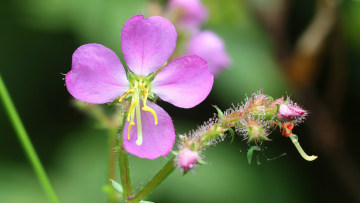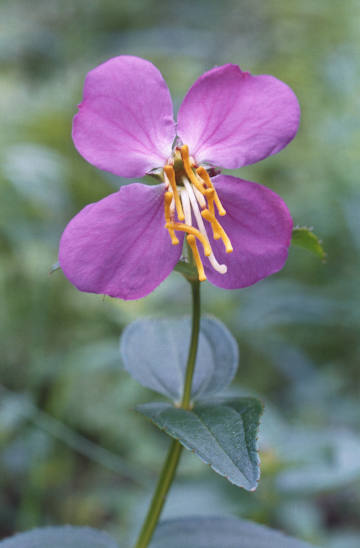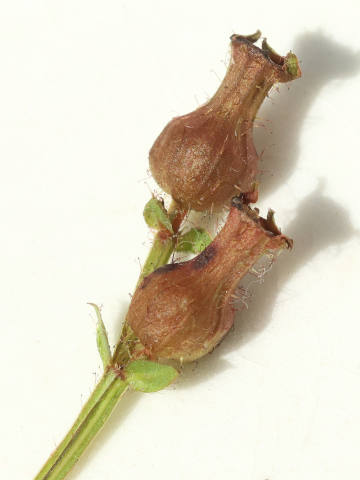Nature Notes

PHOTO COURTESY OF GARRY KESSLER
Virginia meadow-beauty flowers often look slightly lopsided.
September 10, 2023
NATURE NOTES
By Annie Reid
Westborough Community Land Trust
Look for local late-summer beauties
We expect September to be summery and then fall-like, but this year it began with heat and humidity like we had in July. Whether you think that’s good news or bad news, it extended the time for enjoying local end-of-summer wildflowers, including a native wetland dweller that’s both showy and shy, Virginia meadow-beauty.
Virginia meadow-beauty (Rhexis virginica) grows in wet or moist sandy soil. Keep an eye out for it on damp, sandy shores of ponds and streams, or in wet meadows or sunny marshy areas. (What’s a marsh? It’s an open wetland, typically without the woody shrubs and trees found in swamps.)

PHOTO COURTESY OF GARRY KESSLER
Drooping from the center of Virginia meadow-beauty blossoms are long, thin, yellow or orange anthers (male, pollen-bearing parts) and a long, curving, white pistil (female flower part).
Virginia meadow-beauty is showy because of its bright pink or magenta four-petaled flowers with a distinctive lop-sided look. It’s shy because it’s short, only 1 to 1-1/2 feet tall. It’s sometimes easy to miss. You might find a few single plants, or a whole colony.
In a colony, you might find plants at different stages of blooming. The fresh, rose-colored, one-inch blossoms have long, thin, yellow anthers (male, pollen-bearing parts) drooping from their centers, and a long curving pistil (female flower part). To get pollen from these flowers, bumblebees hang on and vibrate their wings to shake the pollen out of the anthers.
After a day or so in bloom, yellow anthers change color, turning orange. These older flowers still attract bees to their vicinity--where other, fresher meadow-beauty flowers bloom—but the color change signals to pollinators that the older flowers’ pollen has already been used up.

PHOTO COURTESY OF GARRY KESSLER
Close-up of Virginia meadow-beauty’s tiny urn-shaped seed capsules.
After blooming, the plants develop dry fruits shaped like tiny Grecian urns. The famous naturalist and writer, Henry David Thoreau of Concord, MA admired these unusual capsules back in the 1800s. When ripe, the capsules split open to release seeds.
In autumn, the leaves of Virginia meadow-beauty turn red. The leaves occur in pairs and have obvious parallel veins.
Deer grass is another name for Virginia meadow-beauty because deer (and moose) like to eat it. You might spot deer hoof prints on a moist shore where the plants grow.
Can we eat it? People have put Virginia meadow-beauty leaves in salads, or boiled them to serve as a green. They have chopped up the small underground tubers for salads. A tea from the leaves has even served as a gargle. But if you find Virginia meadow-beauty in the wild, you might consider it unusual enough to leave alone.
Water levels make a difference in how easy it is to find the plants. Last year’s summer drought made many places too dry for them. This year is just the opposite, with high water levels. Some shores that usually support Virginia meadow-beauty have been under water.
Virginia meadow-beauty also grows on Cape Cod, where there’s also a similar-looking but rare species, Maryland meadow-beauty (Rhexia mariana). It has light pink or white petals. Maryland meadow-beauty is officially protected as endangered in Massachusetts (mass.gov/doc/maryland-meadow-beauty/download).
Don’t miss other late-summer wildflowers, in addition to goldenrods and asters.
At shores, you might still spot brilliant red cardinal flower (Lobelia cardinalis, westboroughlandtrust.org/nn/nn33). In ponds: white water-lilies (Nymphaea odorata, westboroughlandtrust.org/nn/nn106). Near shorelines: closed gentian (Gentiana clausa, westboroughlandtrust.org/nn/nn13).
Look for two roadside and field wildflowers that bloom longer into the day, now that sunlight is less strong. They are common evening primrose (Oenothera biennis, westboroughlandtrust.org/nn/nn61) and chicory (Cichorium intybus, westboroughlandtrust.org/nn/nn128) with its blue flowers.
In wet or damp places, enjoy jewelweed (Impatiens capensis, westboroughlandtrust.org/nn/nn11) with its dangling orange blossoms that attract hummingbirds, and spotted Joe-Pye weed (Eutrochium maculatum, ) in purple.
In dry fields, roadsides, or near trails, find butter-and-eggs toadflax (Linaria vulgaris, westboroughlandtrust.org/nn/nn12) and see why it has that name.
Enjoy them all!
Date index
Month (September)
Common name index
Scientific name index
Category index